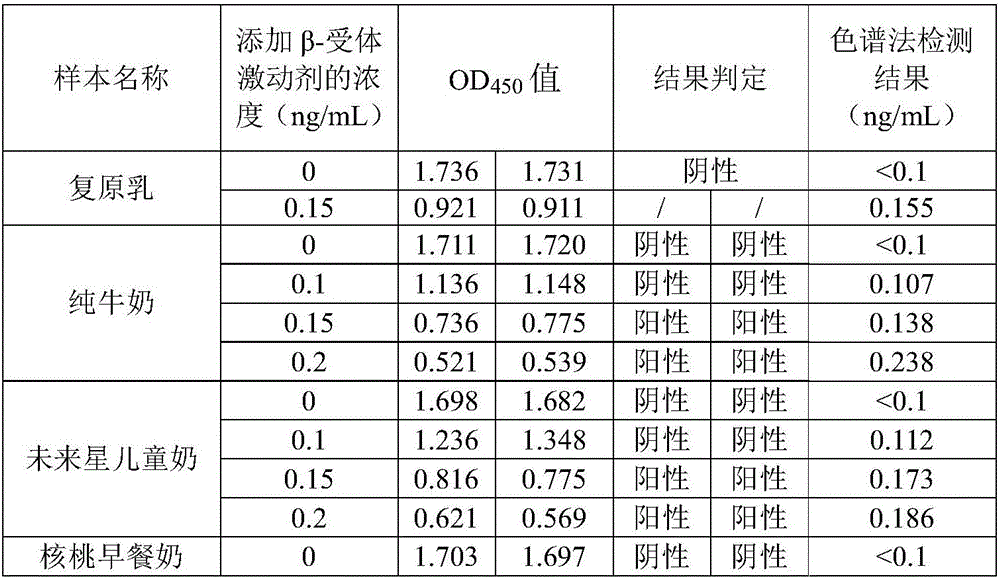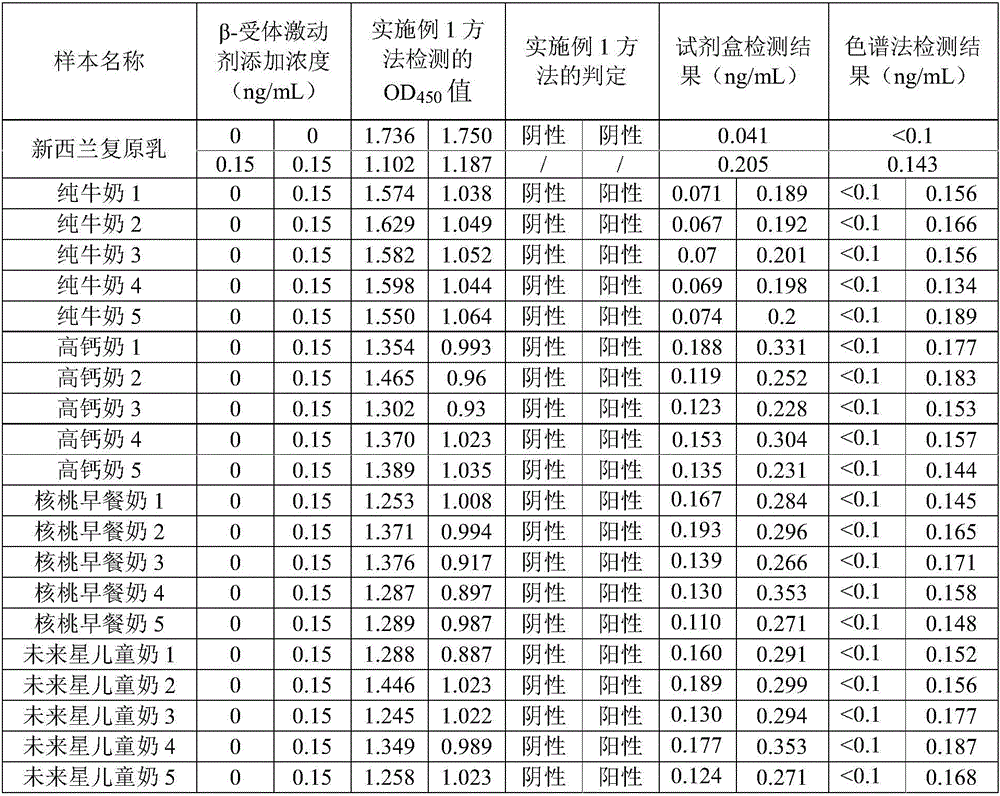Qualitative detection method for content of beta-receptor stimulants in milk
A receptor agonist, qualitative detection technology, applied in the direction of biological testing, material inspection products, etc., can solve the problem that the content of β-receptor agonist needs to be improved
- Summary
- Abstract
- Description
- Claims
- Application Information
AI Technical Summary
Problems solved by technology
Method used
Image
Examples
Embodiment 1
[0022] 1. Reagents and solutions.
[0023] The β-receptor agonist detection kit was purchased from EP Company in the Netherlands.
[0024] The substrate: reconstituted milk obtained by dissolving whole milk powder purchased from New Zealand Fonterra Company in water at a mass ratio of 1:7.
[0025] Positive control: reconstituted milk with known content of β-agonist.
[0026] 2. Equipment and instruments.
[0027] BioTek company's ELx808 microplate reader, detection wavelength: 450nm.
[0028] Waters premier ultra-high performance liquid chromatography tandem mass spectrometer.
[0029] 3. Operation steps.
[0030] (1) Take out the required number of microporous tubes and insert them into the microporous plate, and record the positions of the microwells;
[0031] (2) Centrifuge the substrate, the positive quality control and the milk to be tested at a temperature of 2-8°C and a speed of 3000g for 10 minutes, collect the supernatant, and add the supernatant to the micropor...
Embodiment 2
[0043] accuracy check
[0044] Take 4 kinds of milk samples that do not contain β-receptor agonists, add different concentrations of β-receptor agonist standard products (commercially available) therein according to the concentrations shown in the table below to obtain spiked milk, and use the The method of Example 1 and GB / T22965-2008 "The Determination of 12 Kinds of Beta-Stimulant Residues in Milk and Milk Powder by Liquid Chromatography-Tandem Mass Spectrometry" (hereinafter referred to as chromatography) carried out 2 parallel detections on different spiked milks, The substrate is reconstituted milk without β-receptor agonist, and the positive quality control product is reconstituted milk with 0.15ng / mL β-receptor agonist added.
[0045] The results are shown in Table 1. Add β-receptor agonist standard substances to the four milk samples respectively. When the added concentration is lower than 0.15ng / mL, the absorbance value is higher than that of the positive quality co...
Embodiment 3
[0051] False Positive Rate Detection
[0052] Take 4 kinds of milk samples that do not contain β-receptor agonists, add different concentrations of β-receptor agonist standard products (commercially available) therein according to the concentrations shown in the table below to obtain spiked milk, and use the The method of Example 1, enzyme-linked immunosorbent assay kit and chromatography were used to perform two parallel detections on different spiked milks. The substrate was reconstituted milk without adding β-receptor agonists, and the positive quality control was added with 0.15ng / mL β-agonist reconstituted milk.
[0053] The detection process of the ELISA quantitative kit is as follows:
[0054] (1) Determination of the OD value of the sample to be tested according to steps (1) to (8) of Example 1, wherein step (1) does not need to set the substrate and positive quality control;
[0055] (2) According to the steps (1) to (8) of Example 1, measure the OD values of dif...
PUM
 Login to View More
Login to View More Abstract
Description
Claims
Application Information
 Login to View More
Login to View More - R&D
- Intellectual Property
- Life Sciences
- Materials
- Tech Scout
- Unparalleled Data Quality
- Higher Quality Content
- 60% Fewer Hallucinations
Browse by: Latest US Patents, China's latest patents, Technical Efficacy Thesaurus, Application Domain, Technology Topic, Popular Technical Reports.
© 2025 PatSnap. All rights reserved.Legal|Privacy policy|Modern Slavery Act Transparency Statement|Sitemap|About US| Contact US: help@patsnap.com



